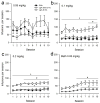Potent rewarding and reinforcing effects of the synthetic cathinone 3,4-methylenedioxypyrovalerone (MDPV)
- PMID: 22784198
- PMCID: PMC3473160
- DOI: 10.1111/j.1369-1600.2012.00474.x
Potent rewarding and reinforcing effects of the synthetic cathinone 3,4-methylenedioxypyrovalerone (MDPV)
Abstract
Reports of abuse and toxic effects of synthetic cathinones, frequently sold as 'bath salts' or 'legal highs', have increased dramatically in recent years. One of the most widely used synthetic cathinones is 3,4-methylenedioxypyrovalerone (MDPV). The current study evaluated the abuse potential of MDPV by assessing its ability to support intravenous self-administration and to lower thresholds for intracranial self-stimulation (ICSS) in rats. In the first experiment, the rats were trained to intravenously self-administer MDPV in daily 2-hour sessions for 10 days at doses of 0.05, 0.1 or 0.2 mg/kg per infusion. The rats were then allowed to self-administer MDPV under a progressive ratio (PR) schedule of reinforcement. Next, the rats self-administered MDPV for an additional 10 days under short access (ShA; 2 hours/day) or long access (LgA; 6 hours/day) conditions to assess escalation of intake. A separate group of rats underwent the same procedures, with the exception of self-administering methamphetamine (0.05 mg/kg per infusion) instead of MDPV. In the second experiment, the effects of MDPV on ICSS thresholds following acute administration (0.1, 0.5, 1 and 2 mg/kg, i.p.) were assessed. MDPV maintained self-administration across all doses tested. A positive relationship between MDPV dose and breakpoints for reinforcement under PR conditions was observed. LgA conditions led to escalation of drug intake at 0.1 and 0.2 mg/kg doses, and rats self-administering methamphetamine showed similar patterns of escalation. Finally, MDPV significantly lowered ICSS thresholds at all doses tested. Together, these findings indicate that MDPV has reinforcing properties and activates brain reward circuitry, suggesting a potential for abuse and addiction in humans.
Keywords: 3; 4-methylenedioxypyrovalerone; abuse liability; bath salt; extended access; intracranial self-stimulation; intravenous self-administration; synthetic cathinone.
© 2012 The Authors, Addiction Biology © 2012 Society for the Study of Addiction.
Figures




Similar articles
-
Abuse-related and abuse-limiting effects of methcathinone and the synthetic "bath salts" cathinone analogs methylenedioxypyrovalerone (MDPV), methylone and mephedrone on intracranial self-stimulation in rats.Psychopharmacology (Berl). 2014 Jan;231(1):199-207. doi: 10.1007/s00213-013-3223-5. Epub 2013 Aug 15. Psychopharmacology (Berl). 2014. PMID: 23949206 Free PMC article.
-
Reinforcing Effects of Binary Mixtures of Common Bath Salt Constituents: Studies with 3,4-Methylenedioxypyrovalerone (MDPV), 3,4-Methylenedioxymethcathinone (methylone), and Caffeine in Rats.Neuropsychopharmacology. 2018 Mar;43(4):761-769. doi: 10.1038/npp.2017.141. Epub 2017 Jul 5. Neuropsychopharmacology. 2018. PMID: 28677665 Free PMC article.
-
Self-administration of the synthetic cathinones 3,4-methylenedioxypyrovalerone (MDPV) and α-pyrrolidinopentiophenone (α-PVP) in rhesus monkeys.Psychopharmacology (Berl). 2019 Dec;236(12):3677-3685. doi: 10.1007/s00213-019-05339-4. Epub 2019 Jul 26. Psychopharmacology (Berl). 2019. PMID: 31346629 Free PMC article.
-
Synthetic cathinones: chemical phylogeny, physiology, and neuropharmacology.Life Sci. 2014 Feb 27;97(1):20-6. doi: 10.1016/j.lfs.2013.10.029. Epub 2013 Nov 11. Life Sci. 2014. PMID: 24231923 Free PMC article. Review.
-
Neurobiology of 3,4-methylenedioxypyrovalerone (MDPV) and α-pyrrolidinovalerophenone (α-PVP).Brain Res Bull. 2016 Sep;126(Pt 1):111-126. doi: 10.1016/j.brainresbull.2016.04.011. Epub 2016 Apr 29. Brain Res Bull. 2016. PMID: 27142261 Free PMC article. Review.
Cited by
-
Sensitization to the motor stimulant effects of 3,4-methylenedioxypyrovalerone (MDPV) and cross-sensitization to methamphetamine in rats.J Drug Alcohol Res. 2016 May;5:235967. doi: 10.4303/jdar/235967. J Drug Alcohol Res. 2016. PMID: 27284493 Free PMC article.
-
Behavioral economic analysis of the reinforcing effects of "bath salts" mixtures: studies with MDPV, methylone, and caffeine in male Sprague-Dawley rats.Psychopharmacology (Berl). 2019 Mar;236(3):1031-1041. doi: 10.1007/s00213-018-5046-x. Epub 2018 Sep 29. Psychopharmacology (Berl). 2019. PMID: 30267131 Free PMC article.
-
Contribution of monoaminergic mechanisms to the discriminative stimulus effects of 3,4-methylenedioxypyrovalerone (MDPV) in Sprague-Dawley rats.Psychopharmacology (Berl). 2019 Mar;236(3):963-971. doi: 10.1007/s00213-018-5145-8. Epub 2018 Dec 15. Psychopharmacology (Berl). 2019. PMID: 30554256 Free PMC article.
-
Abuse-related and abuse-limiting effects of methcathinone and the synthetic "bath salts" cathinone analogs methylenedioxypyrovalerone (MDPV), methylone and mephedrone on intracranial self-stimulation in rats.Psychopharmacology (Berl). 2014 Jan;231(1):199-207. doi: 10.1007/s00213-013-3223-5. Epub 2013 Aug 15. Psychopharmacology (Berl). 2014. PMID: 23949206 Free PMC article.
-
Behavioural, Pharmacokinetic, Metabolic, and Hyperthermic Profile of 3,4-Methylenedioxypyrovalerone (MDPV) in the Wistar Rat.Front Psychiatry. 2018 Apr 24;9:144. doi: 10.3389/fpsyt.2018.00144. eCollection 2018. Front Psychiatry. 2018. PMID: 29740356 Free PMC article.
References
-
- Ahmed SH. Transition from moderate to excessive drug intake: change in hedonic set point. Science. 1998;282:298–300. - PubMed
-
- Ahmed S. Escalation of drug use. In: Olmstead MC, editor. Animal Models of Drug Addiction. Humana Press; Totowa, NJ: 2011. pp. 267–292.
-
- American Psychiatric Association. Diagnostic and Statistical Manual of Mental Disorders, DSM-IV-TR. American Psychiatric Press; Washington, DC: 2004.
-
- Collins RJ, Weeks JR, Cooper MM, Good PI, Russell RR. Prediction of abuse liability of drugs using IV self-administration by rats. Psychopharmacology. 1983;82:6–13. - PubMed
-
- Coppola M, Mondola R. 3,4-Methylenedioxypyrovalerone (MDPV): Chemistry, pharmacology and toxicology of a new designer drug of abuse marketed online. Toxicol Lett. 2012;208:12–15. - PubMed
Publication types
MeSH terms
Substances
Grants and funding
LinkOut - more resources
Full Text Sources
Research Materials

